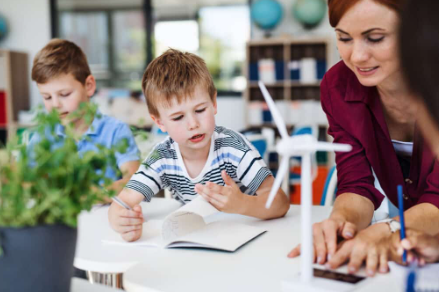
In today’s rapidly evolving educational landscape, fostering student engagement has become more critical than ever. One highly effective approach that has proven successful in this regard is Project-Based Learning (PBL). By immersing students in real-world projects that challenge their creativity and critical thinking, PBL encourages active participation, collaboration, and deeper learning.
In this post, we explore a case study on implementing project-based learning in a classroom setting to enhance student engagement, participation, and enthusiasm for learning.
Background: The Need for Project-Based Learning
At Greenwood Middle School, teachers noticed a decline in student engagement and motivation. Traditional teaching methods, focused primarily on lectures and worksheets, were not connecting with the diverse needs of their students. The administration decided to experiment with Project-Based Learning (PBL) as a solution to foster greater student involvement.
The aim was to create a dynamic learning environment where students could actively participate, explore, and solve real-world problems while building key skills such as communication, collaboration, and critical thinking.
The PBL Implementation Strategy
- Defining Learning Objectives: The school started by outlining clear learning objectives aligned with the curriculum. These objectives focused on essential skills such as problem-solving, teamwork, and creativity. Teachers collaborated to design projects that would incorporate these objectives while allowing flexibility in how students approached them.
- Designing Real-World Projects: The teachers developed projects that related to real-world scenarios. For example, a science project involved designing a sustainable garden, while a social studies project had students create a digital documentary on local history. Each project was structured to require research, planning, creativity, and presentation.
- Forming Collaborative Groups: Students were grouped into small, diverse teams to encourage collaboration. Each team had a mix of strengths and learning styles to ensure that all members could contribute meaningfully. Teachers facilitated discussions and guided students on how to delegate tasks and work together.
- Integrating Technology: To enhance engagement, the school integrated various digital tools into the projects. Students used apps and software for research, communication, and presentation. This not only made the projects more interactive but also equipped students with essential digital skills.
- Providing Continuous Feedback: Teachers provided continuous feedback throughout the project phases. Rather than waiting until the end, they held regular check-ins to assess progress, offer guidance, and encourage students. Feedback sessions were designed to be constructive, focusing on both strengths and areas for improvement.
- Reflecting and Presenting: At the end of each project, students presented their work to their peers, teachers, and even community members. Reflection sessions were held to discuss what they learned, the challenges they faced, and how they overcame them. This process reinforced the learning experience and helped build confidence.
Results: How PBL Boosted Student Engagement
The implementation of Project-Based Learning resulted in several positive outcomes:
- Increased Student Engagement: Students showed a higher level of enthusiasm and participation in their projects. They took ownership of their learning and were more motivated to attend classes and complete tasks.
- Improved Critical Thinking Skills: By engaging with real-world problems, students developed stronger critical thinking and problem-solving skills. They learned to analyze situations, gather information, and develop innovative solutions.
- Enhanced Collaboration: Working in diverse groups improved teamwork skills. Students learned to listen to others, share their ideas, and collaborate effectively to achieve a common goal.
- Greater Creativity and Innovation: PBL allowed students to explore creative solutions and express their ideas in unique ways. The projects encouraged them to think outside the box and use their imagination.
- Stronger Communication Skills: Presenting their projects to an audience helped students develop their communication and public speaking skills. They learned to articulate their ideas clearly and confidently.
Challenges Faced and Overcome
While the benefits were significant, there were challenges to implementing PBL:
- Time Management: Some students struggled with managing time effectively. Teachers introduced time management tools and strategies to help students stay on track.
- Balancing Group Dynamics: Managing diverse teams posed some difficulties. Teachers had to mediate conflicts and guide students on effective collaboration techniques.
- Resource Allocation: Some projects required resources that were not readily available. The school partnered with local businesses and organizations to secure necessary materials and support.
Lessons Learned from the Case Study
The case study at Greenwood Middle School provides valuable insights into how Project-Based Learning can be effectively implemented to boost student engagement:
- Start Small: Begin with smaller projects to familiarize students and teachers with the PBL approach before scaling up to more complex projects.
- Encourage Flexibility: Allow room for student choice and creativity. Flexibility helps cater to different learning styles and interests, making learning more personalized and effective.
- Use Real-World Connections: Tie projects to real-world scenarios that are relevant to the students’ lives. This helps make learning more meaningful and engaging.
- Provide Ongoing Support: Ensure that both students and teachers receive continuous support throughout the project. Regular feedback and guidance are crucial for success.
Conclusion: The Power of Project-Based Learning
The case study demonstrates that Project-Based Learning is a powerful strategy for boosting student engagement. Creating a dynamic, interactive, and student-centered environment, PBL encourages active participation, fosters essential skills, and makes learning enjoyable and meaningful.
Ready to explore more innovative teaching strategies that can transform your classroom? Subscribe to our blog to receive regular updates, tips, and case studies on effective educational practices. Join our community of educators dedicated to fostering meaningful learning experiences!










